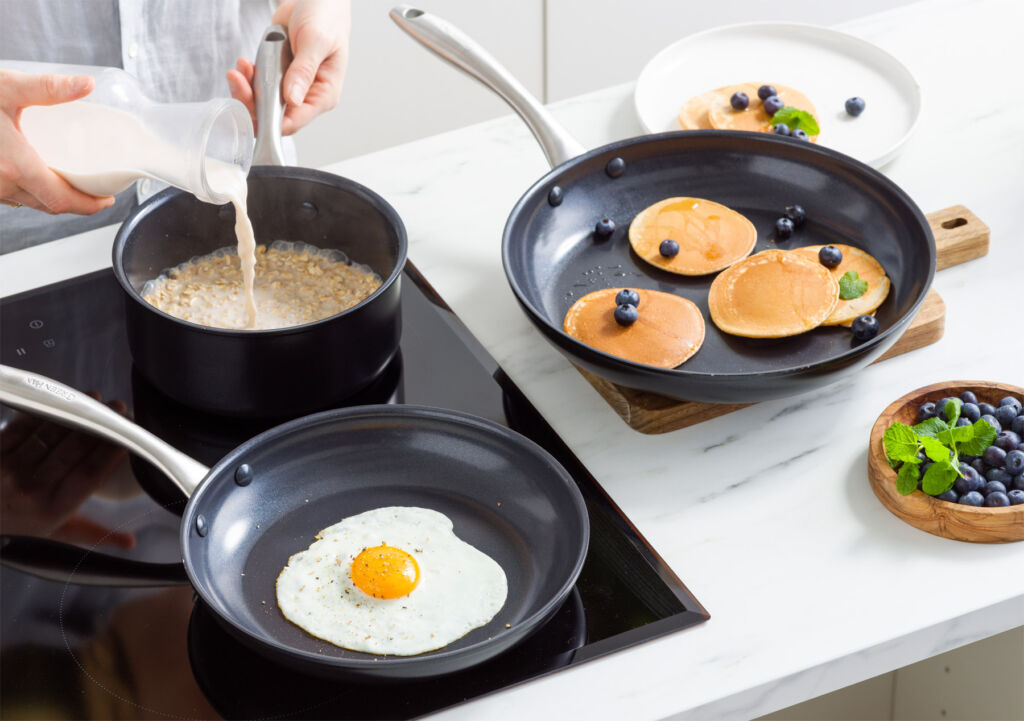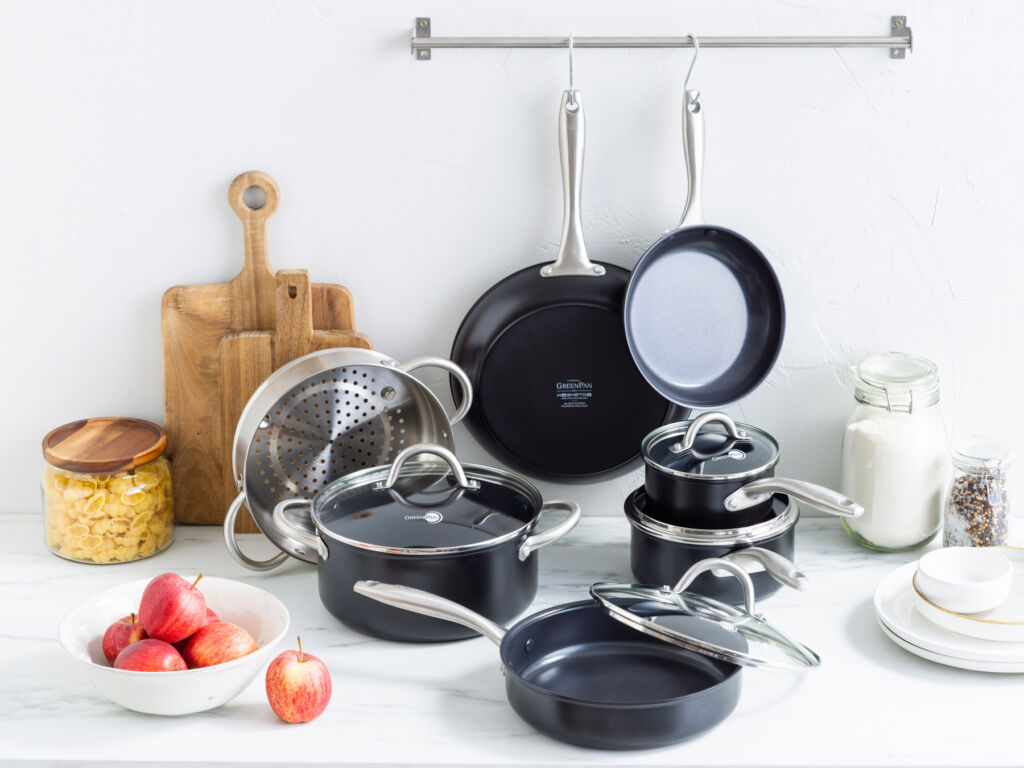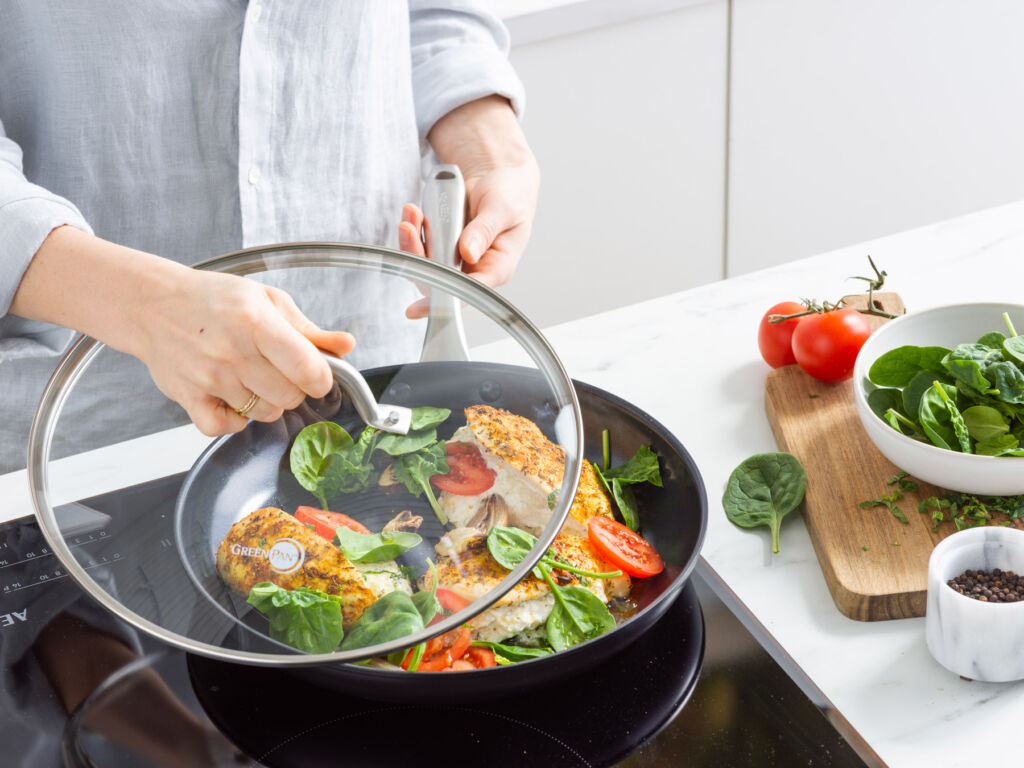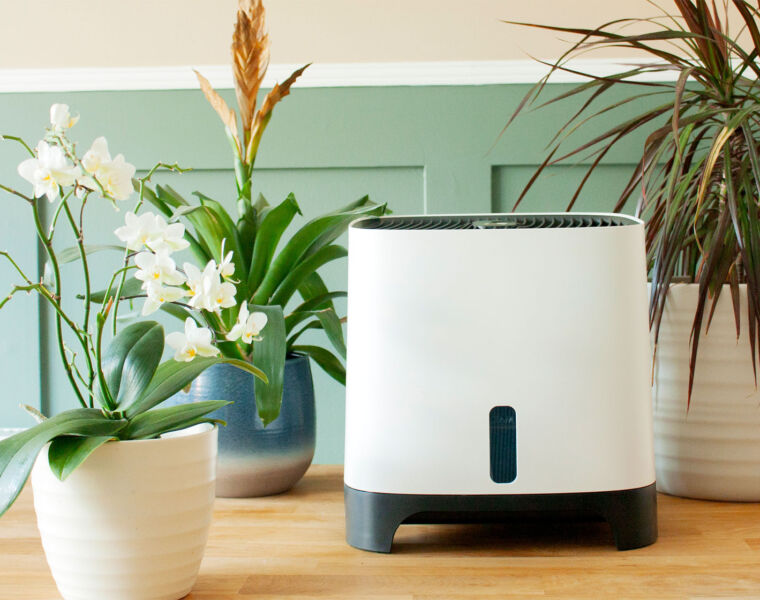
In this feature, we’ll focus on GreenPan, a company that has changed how people cook and stands front and centre in the battle against PFAS for the good of the planet and its inhabitants. We explain why winning this battle is crucial, and to help gain more insight into how GreenPan is fighting the fight, we try out its Lima Midnight Cookware Collection on our newly fitted induction hob.
For those who might not know, PFAS, or per- and poly-fluoroalkyl substances, is a group of approximately 10,000 fluorinated chemicals, also known as ‘Forever Chemicals’. Although some might have heard of them, they will likely need help understanding why they exist. Therefore, before diving head-first into the world of GreenPan, we’ll look at the story behind the chemicals.
For more than 20,000 years, humankind has cooked without the need for PFAS chemicals. In the 1930s, a product was accidentally developed in a laboratory, resulting in the birth of PFAS chemistry. Roy J. Plunkett, a research chemist at a company known today as DuPont, is credited with making the discovery.

While working with the chemical, Plunkett and his assistant, Jack Rebok, discovered that when frozen, the chemicals turned into a waxy, white-coloured solid. This led them to explore how the substance could be used. It took until 1953 for scientists at 3M to figure out how to bring it to the market, resulting in the birth of Teflon, a name synonymous with cookware.
Aside from their well-known link with pots and pans, PFAS chemicals are found in many other products that require resistance to heat, oil, stains, grease, and water. Most will likely be unaware that they are used today in all manner of waterproof fabrics, carpets and shampoo, cosmetic products such as lip balm, mascara, and nail polish, mobile phone screens, paint, food packaging, and more, which some might say is ‘far too close to home’.
PFAS are known as ‘forever chemicals’ because their precise expiration date remains unknown. Unfortunately for all of us, experts’ best guess is that some or many of the chemicals will still exist in 1000+ years.
Why PFAS Should Be of Concern to Everyone
We rarely use the word battle in a headline, however, the word is entirely fitting. In these times of global conflicts, which are affecting the lives of millions, another less-known battle is being waged, and it is fronted by companies like GreenPan, who are fighting against an invisible and dangerous foe that is very possibly causing harm to all life on the planet.

Most people would correctly assume that anything that could shorten human lifespans would be removed rather sharpish from the market; after all, some products used for medical treatments in recent years have suddenly disappeared as soon as any red flags were raised. Sadly, chemicals and medications seem to conform to different rules, and eliminating PFAS chemicals from the consumer market seems easier said than done.
The EU’s European Green Deal 2020¹ outlined a pathway to banning the use of the most harmful chemicals in consumer products (up to 12,000, including PFAs), restricting their use to only essential areas. However, according to some 2023 and 2024 news media reports, the power and sway of large chemical corporations and lobbyists seem to have won the day, as leaked documents indicate that whatever is implemented by the EU would be a significantly watered-down version of what it initially envisaged.
In an October 2023 editorial in the Guardian, Tatiana Santos, the head of chemicals policy at the European Environmental Bureau (EEB), a network of environmental citizens’ organisations, said that by shelving the promised review of the EU’s Reach regulation that governs chemicals, “the European Commission has betrayed citizens, turning a blind eye to chemical pollution and favoured toxic industry’s short-term interests over those of its citizens.”

The Health Implications
Ingesting PFAS chemicals is worryingly easy; ridding them from your body isn’t. The impact of PFAS chemicals on health is widely documented, and the consensus is that they are toxic to humans.
The obvious ways for the chemicals to enter the body are through ingestion and inhalation. However, there is another lesser-known and equally worrying way they can get inside you; researchers at the University of Birmingham have conducted a study that shows that forever chemicals can also enter the bloodstream through contact with the skin.
PFAS chemicals are believed to remain unchanged in the body for long periods. It can take more than seven years for the body to half the amount in the bloodstream, and let’s not forget that if precautions are not taken now, such as switching to PFAS-free cookware, the amounts in the bloodstream will continue to increase.
Although less research exists into the damaging effects of PFAS on ecosystems and other forms of life, considerable research is widely available today showing their direct impact on humans, and it does not make good reading. The chemicals can cause multiple health problems, such as liver damage, thyroid disease, obesity, a reduction in the immune system’s ability to fight infections, fertility issues, cancer, and more.
Ascertaining how many fatalities have been caused by PFAS is challenging. The chemicals have been in the consumer market for approximately seventy years, and they are a contributing factor to ill health rather than a disease. What I mean by this is that if a person develops cancer and passes away, the cause will go down as ‘cancer’ on a certificate; it is unlikely that medical professionals will check for adverse chemical levels in the body to try to establish a causal link.
Also, if medical technology had been available in the last century, the negative impact of PFAS on one’s health would have been far less researched, and in times before the internet, information would have been difficult for consumers to access.
As we say in England, “Out of sight, out of mind.”
Even if the battle against PFAS was won today, and companies worldwide were forced to stop using them in their products, their adverse effects would still plague multiple generations to come.

The GreenPan Way
Undoubtedly, some reading this will have been unaware of the hidden dangers PFAS bring, and relying on bodies such as the EU and elected governments to remove them from everyday products will likely result in a long wait.
Eliminating all PFAS chemicals from your life is impossible at this present time. However, you can significantly reduce the amounts you intake. Good places to start are through filtering tap water and using cookware that you can guarantee is free from unnecessary chemicals, which leads us nicely to GreenPan.
GreenPan is a company we hold in the highest regard. It is one of those very rare companies that had set its “Make the world a better place” stall out right from the start by inventing ceramic non-stick coating for cookware. In 2007, it began its mission to change the way the world cooks with stylish, safe, PFAS-free, non-stick products, and since then, it has gone from strength to strength.
The company’s stance on making the world ‘a greener place’ was ahead of its time. Unlike the many other companies that have since jumped on the ‘Green Bandwagon’, doing little more than greenwashing, the only ‘greenwashing’ you’ll experience with GreenPan is when you pop its products in the sink or the dishwasher.
Our only experience with the company’s products was with its Slow Cooker, which we found to be highly efficient, stylish and appropriate for this day and age; it was a money saver.
However, although we have been given many opportunities, we have yet to get ‘hands-on’ with its pots and pans. To ensure we had a fuller experience of what the company does, and following the recent installation of our new kitchen, replete with an induction hob, we took the opportunity to test out its Lima Midnight Cookware Collection.

The GreenPan Lima Midnight Cookware Collection
GreenPan’s Lima Midnight Collection is an 11-piece set suitable for all hobs, including induction. It comprises a 20cm 3L saucepan with lid, a 28cm griddle pan, 20cm and 26cm frying pans, a 30cm 4.8L saute pan, a 30cm frying pan, and a 28cm grill pan.
Each pan in the set uses GreenPan’s Thermolon™ coating, which is PFAS-free and made from a sand derivative. To ensure its products are the safest and the best they can be, the company has a dedicated research and development team that continuously tests its creations against similar products in the market.

Another big tick in the box is the world-first Thermolon™ non-stick coating is made in-house and closely monitored at the Greenspan factory rather than being ‘farmed’ out.
I don’t want to cast aspersions on other manufacturers, but the lower-priced products on shopping sites such as Amazon and the cookware ranges found in supermarkets do not fill me with confidence.
Any health claims printed on the packaging or stamped on their products are almost impossible to verify. They are usually the product of a long multi-country manufacturing chain, which makes determining whether they are truly safe to use little more than a ‘leap of faith’.
Given how detrimental PFAS chemicals can be to one’s health, you need to buy from a company that’s made its name on being the safest in the market. In this respect, the adage “It’s better to be safe than sorry” springs to mind.
An ongoing problem with most regular cookware is that its surfaces degrade over time with regular use, and products made with harmful chemicals will use this as a shortcut into the body. GreenPan’s products are made with scratch-resistant anodised bodies, which are so tough that you can use them with metal utensils.
Another thing to note is that when subjected to high heat, inferior products can give off toxic fumes, releasing PFAS chemicals into the air, which are then easily ingested. GreenPan’s products are not capable of doing this, meaning that this will never be a concern.

Individually, the pieces in the GreenPan Lima Midnight collection look great. They have black hard anodised aluminium bodies, matte stainless steel handles, and glass lids.
The combination brings a classy look to the kitchen and showcases to others that the person at the hob means business. Each piece is well-weighted and feels good in the hands, and the ergonomically designed stainless steel cool-touch matte handles reinforce this feeling of comfort.
GreenPan leads the way in more than just the practicality and looks departments. The company continuously invents ways to make cooking safer and more efficient, and at the time of this writing, it has registered more than 150 patents, many of which are in the Lima Midnight Collection.
Although testing the efficacy of one brand of pans versus another is beyond our current means, we found that when using the pans, the food was evenly cooked and took less time than expected compared to the inferior quality pans we had purchased. Of course, this could be due to our lack of experience with using an induction hob.

However, I feel it is more likely due to another of the GreenPan patents, which is called Magneto™.
If you’re familiar with pots and pans that can be used on an induction hob, you’ll often notice that they sport a fancy, distinctive pattern on the base. This pattern is often made using a separate piece of metal from the main body. In time, these two metals will often warp; this is known as the bimetal effect.
GreenPan’s Magneto™ overcomes this by spraying ferromagnetic particles reinforced with copper to the bottom of each pot and pan, which means they will not be subject to warpage. According to GreenPan, another benefit of Magneto™ is that it produces a more even heat faster.
To ensure the pots and pans look their best for as long as possible, each piece in the collection is coated with Evershine™, an electrochemical surface treatment applied to the outside of the pan that prevents stains from forming.

We couldn’t end our experience of the Lima Midnight Collection without mentioning the glass lids. Each lid proudly carries the GreenPan logo and contains tempered glass, which makes them safe to use in an oven at up to 220°C.
Final Thoughts
The Lima Midnight Collection did everything we expected with aplomb. It is an attractive-looking set that brings peace of mind to the kitchen through clever design, innovation, and high-quality construction.
Many readers will have pots and pans in their cupboards sporting well-known names. They’ll use them to cook healthy food without considering what else is imparted into their culinary creations. If you want peace of mind and your goal is to cook foods in the healthiest possible way, the answer is simple, and its GreenPan.
The Lima cookware collection we tested comprised: Stainless Steel open Steamer 24 cm, Frypan 20 cm and 26 cm, Saucepan with Lid 14 cm/1.07L and 18 cm/2.01L, Casserole with Lid 24 cm/4.91L, Skillet with Lid 28 cm/2.65L.
For more information on all the GreenPan products and to make a purchase, please visit https://greenpan.co.uk/.
¹ https://www.consilium.europa.eu/en/policies/green-deal/![]()




You must be logged in to post a comment.